常用介词用法(for to with of).
- 格式:doc
- 大小:26.00 KB
- 文档页数:9
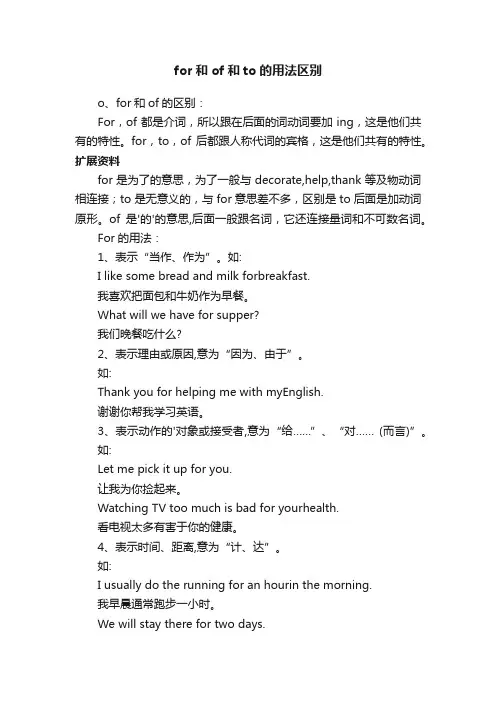
for和of和to的用法区别o、for和of的区别:For,of都是介词,所以跟在后面的词动词要加ing,这是他们共有的特性。
for,to,of后都跟人称代词的宾格,这是他们共有的特性。
扩展资料for是为了的意思,为了一般与decorate,help,thank等及物动词相连接;to是无意义的,与for意思差不多,区别是to后面是加动词原形。
of是'的'的意思,后面一般跟名词,它还连接量词和不可数名词。
For的用法:1、表示“当作、作为”。
如:I like some bread and milk forbreakfast.我喜欢把面包和牛奶作为早餐。
What will we have for supper?我们晚餐吃什么?2、表示理由或原因,意为“因为、由于”。
如:Thank you for helping me with myEnglish.谢谢你帮我学习英语。
3、表示动作的'对象或接受者,意为“给……”、“对…… (而言)”。
如:Let me pick it up for you.让我为你捡起来。
Watching TV too much is bad for yourhealth.看电视太多有害于你的健康。
4、表示时间、距离,意为“计、达”。
如:I usually do the running for an hourin the morning.我早晨通常跑步一小时。
We will stay there for two days.我们将在那里逗留两天。
5、表示去向、目的,意为“向、往、取、买”等。
如:Let’s go for a walk.我们出去散步吧。
I came here for my schoolbag.我来这儿取书包。
I paid twenty yuan for thedictionary.我花了20元买这本词典。
6、表示所属关系或用途,意为“为、适于……的”。
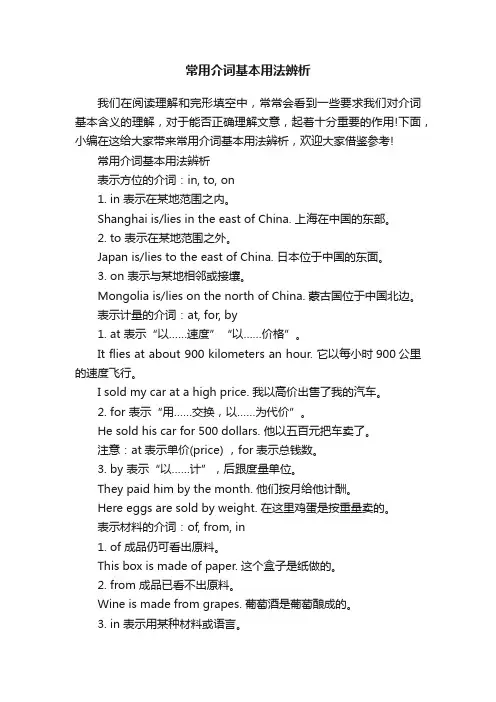
常用介词基本用法辨析我们在阅读理解和完形填空中,常常会看到一些要求我们对介词基本含义的理解,对于能否正确理解文意,起着十分重要的作用!下面,小编在这给大家带来常用介词基本用法辨析,欢迎大家借鉴参考!常用介词基本用法辨析表示方位的介词:in, to, on1. in 表示在某地范围之内。
Shanghai is/lies in the east of China. 上海在中国的东部。
2. to 表示在某地范围之外。
Japan is/lies to the east of China. 日本位于中国的东面。
3. on 表示与某地相邻或接壤。
Mongolia is/lies on the north of China. 蒙古国位于中国北边。
表示计量的介词:at, for, by1. at 表示“以……速度”“以……价格”。
It flies at about 900 kilometers an hour. 它以每小时900公里的速度飞行。
I sold my car at a high price. 我以高价出售了我的汽车。
2. for 表示“用……交换,以……为代价”。
He sold his car for 500 dollars. 他以五百元把车卖了。
注意:at表示单价(price) ,for表示总钱数。
3. by 表示“以……计”,后跟度量单位。
They paid him by the month. 他们按月给他计酬。
Here eggs are sold by weight. 在这里鸡蛋是按重量卖的。
表示材料的介词:of, from, in1. of 成品仍可看出原料。
This box is made of paper. 这个盒子是纸做的。
2. from 成品已看不出原料。
Wine is made from grapes. 葡萄酒是葡萄酿成的。
3. in 表示用某种材料或语言。
Please fill in the form in pencil first. 请先用铅笔填写这个表格。
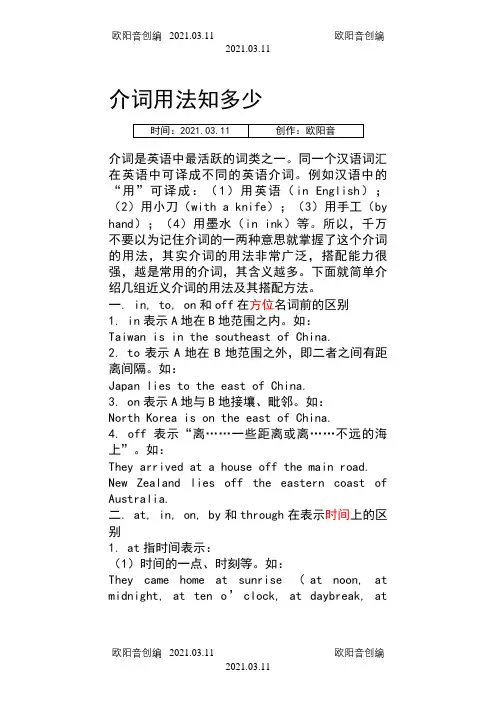
介词用法知多少介词是英语中最活跃的词类之一。
同一个汉语词汇在英语中可译成不同的英语介词。
例如汉语中的“用”可译成:(1)用英语(in English);(2)用小刀(with a knife);(3)用手工(by hand);(4)用墨水(in ink)等。
所以,千万不要以为记住介词的一两种意思就掌握了这个介词的用法,其实介词的用法非常广泛,搭配能力很强,越是常用的介词,其含义越多。
下面就简单介绍几组近义介词的用法及其搭配方法。
一. in, to, on和off在方位名词前的区别1. in表示A地在B地范围之内。
如:Taiwan is in the southeast of China.2. to表示A地在B地范围之外,即二者之间有距离间隔。
如:Japan lies to the east of China.3. on表示A地与B地接壤、毗邻。
如:North Korea is on the east of China.4. off表示“离……一些距离或离……不远的海上”。
如:They arrived at a house off the main road. New Zealand lies off the eastern coast of Australia.二. at, in, on, by和through在表示时间上的区别1. at指时间表示:(1)时间的一点、时刻等。
如:They came home at sunrise (at noon, at midnight, at ten o’clock, at daybreak, atdawn).(2)较短暂的一段时间。
可指某个节日或被认为是一年中标志大事的日子。
如:He went home at Christmas (at New Year, at the Spring Festival, at night).2. in指时间表示:(1)在某个较长的时间(如世纪、朝代、年、月、季节以及泛指的上午、下午或傍晚等)内。
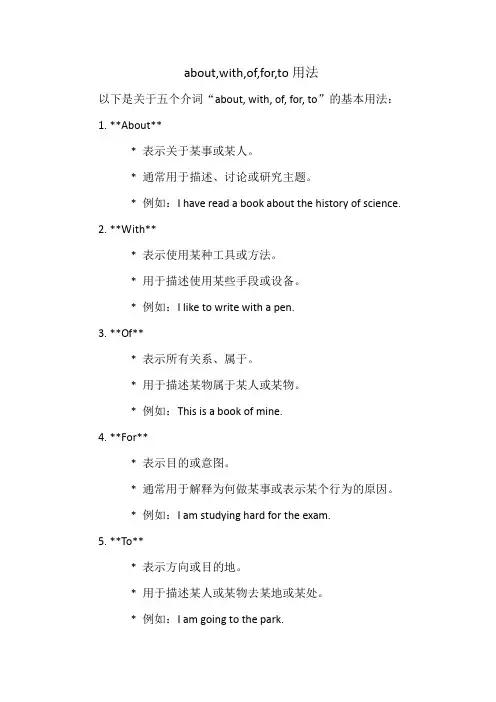
about,with,of,for,to用法
以下是关于五个介词“about, with, of, for, to”的基本用法:1. **About**
* 表示关于某事或某人。
* 通常用于描述、讨论或研究主题。
* 例如:I have read a book about the history of science.
2. **With**
* 表示使用某种工具或方法。
* 用于描述使用某些手段或设备。
* 例如:I like to write with a pen.
3. **Of**
* 表示所有关系、属于。
* 用于描述某物属于某人或某物。
* 例如:This is a book of mine.
4. **For**
* 表示目的或意图。
* 通常用于解释为何做某事或表示某个行为的原因。
* 例如:I am studying hard for the exam.
5. **To**
* 表示方向或目的地。
* 用于描述某人或某物去某地或某处。
* 例如:I am going to the park.
这五个介词的用法相当复杂,因此建议查阅英语语法书籍或咨询英语教师,以获取更详细和准确的信息。
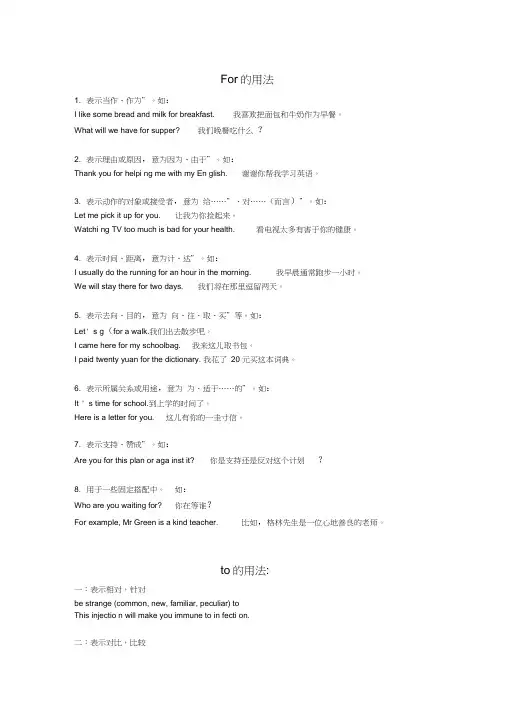
For的用法1. 表示当作、作为”。
如:I like some bread and milk for breakfast. 我喜欢把面包和牛奶作为早餐。
What will we have for supper? 我们晚餐吃什么?2. 表示理由或原因,意为因为、由于”。
如:Thank you for helpi ng me with my En glish. 谢谢你帮我学习英语。
3. 表示动作的对象或接受者,意为给……”、对……(而言)”。
如:Let me pick it up for you. 让我为你捡起来。
Watchi ng TV too much is bad for your health. 看电视太多有害于你的健康。
4. 表示时间、距离,意为计、达”。
如:I usually do the running for an hour in the morning. 我早晨通常跑步一小时。
We will stay there for two days. 我们将在那里逗留两天。
5. 表示去向、目的,意为向、往、取、买”等。
如:Let' s g(for a walk.我们出去散步吧。
I came here for my schoolbag. 我来这儿取书包。
I paid twenty yuan for the dictionary. 我花了20 元买这本词典。
6. 表示所属关系或用途,意为为、适于……的”。
如:It ' s time for school.到上学的时间了。
Here is a letter for you. 这儿有你的一圭寸信。
7. 表示支持、赞成”。
如:Are you for this plan or aga inst it? 你是支持还是反对这个计划?8. 用于一些固定搭配中。
如:Who are you waiting for? 你在等谁?For example, Mr Green is a kind teacher. 比如,格林先生是一位心地善良的老师。
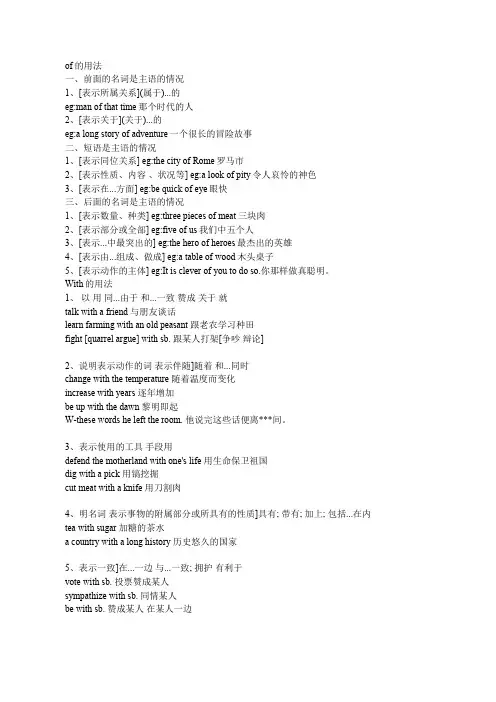
of的用法一、前面的名词是主语的情况1、[表示所属关系](属于)...的eg:man of that time那个时代的人2、[表示关于](关于)...的eg:a long story of adventure一个很长的冒险故事二、短语是主语的情况1、[表示同位关系] eg:the city of Rome罗马市2、[表示性质、内容、状况等] eg:a look of pity令人哀怜的神色3、[表示在...方面] eg:be quick of eye眼快三、后面的名词是主语的情况1、[表示数量、种类] eg:three pieces of meat三块肉2、[表示部分或全部] eg:five of us我们中五个人3、[表示...中最突出的] eg:the hero of heroes最杰出的英雄4、[表示由...组成、做成] eg:a table of wood木头桌子5、[表示动作的主体] eg:It is clever of you to do so.你那样做真聪明。
With的用法1、以用同...由于和...一致赞成关于就talk with a friend 与朋友谈话learn farming with an old peasant 跟老农学习种田fight [quarrel argue] with sb. 跟某人打架[争吵辩论]2、说明表示动作的词表示伴随]随着和...同时change with the temperature 随着温度而变化increase with years 逐年增加be up with the dawn 黎明即起W-these words he left the room. 他说完这些话便离***间。
3、表示使用的工具手段用defend the motherland with one's life 用生命保卫祖国dig with a pick 用镐挖掘cut meat with a knife 用刀割肉4、明名词表示事物的附属部分或所具有的性质]具有; 带有; 加上; 包括...在内tea with sugar 加糖的茶水a country with a long history 历史悠久的国家5、表示一致]在...一边与...一致; 拥护有利于vote with sb. 投票赞成某人sympathize with sb. 同情某人be with sb. 赞成某人在某人一边6、[表示随身携带]在...身边Have you some money with you ? 你(身上)带钱了吗?Take an umbrella with you. 随身带把伞去。
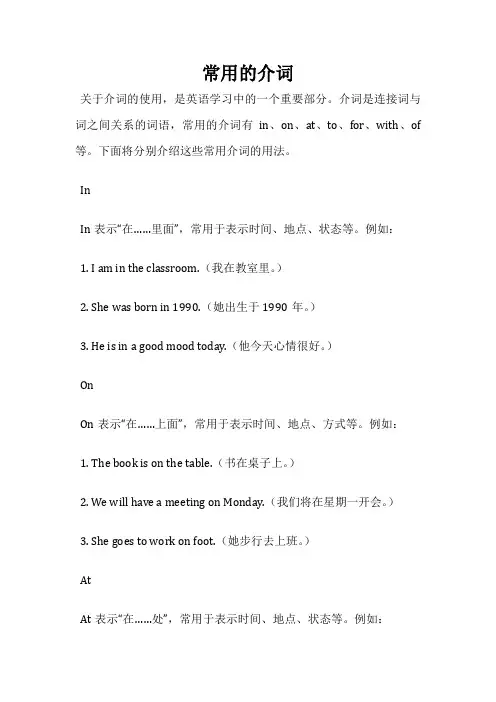
常用的介词关于介词的使用,是英语学习中的一个重要部分。
介词是连接词与词之间关系的词语,常用的介词有in、on、at、to、for、with、of 等。
下面将分别介绍这些常用介词的用法。
InIn表示“在……里面”,常用于表示时间、地点、状态等。
例如:1. I am in the classroom.(我在教室里。
)2. She was born in 1990.(她出生于1990年。
)3. He is in a good mood today.(他今天心情很好。
)OnOn表示“在……上面”,常用于表示时间、地点、方式等。
例如:1. The book is on the table.(书在桌子上。
)2. We will have a meeting on Monday.(我们将在星期一开会。
)3. She goes to work on foot.(她步行去上班。
)AtAt表示“在……处”,常用于表示时间、地点、状态等。
例如:1. I will meet you at the airport.(我会在机场见你。
)2. He is good at playing basketball.(他擅长打篮球。
)3. We arrived at the hotel at midnight.(我们在午夜到达了酒店。
) ToTo表示“到……”,常用于表示方向、目的等。
例如:1. I am going to the supermarket.(我要去超市。
)2. He gave the book to me.(他把书给了我。
)3. She is looking forward to the weekend.(她期待着周末。
)ForFor表示“为了……”,常用于表示目的、原因等。
例如:1. I bought a gift for my mother.(我给我妈妈买了一份礼物。
)2. He is studying hard for the exam.(他为了考试而努力学习。
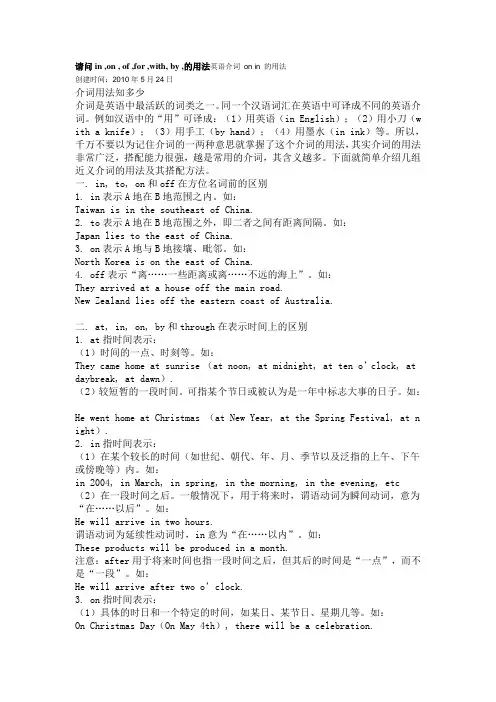
请问in ,on , of ,for ,with, by ,的用法英语介词on in 的用法创建时间:2010年5月24日介词用法知多少介词是英语中最活跃的词类之一。
同一个汉语词汇在英语中可译成不同的英语介词。
例如汉语中的“用”可译成:(1)用英语(in English);(2)用小刀(w ith a knife);(3)用手工(by hand);(4)用墨水(in ink)等。
所以,千万不要以为记住介词的一两种意思就掌握了这个介词的用法,其实介词的用法非常广泛,搭配能力很强,越是常用的介词,其含义越多。
下面就简单介绍几组近义介词的用法及其搭配方法。
一. in, to, on和off在方位名词前的区别1. in表示A地在B地范围之内。
如:Taiwan is in the southeast of China.2. to表示A地在B地范围之外,即二者之间有距离间隔。
如:Japan lies to the east of China.3. on表示A地与B地接壤、毗邻。
如:North Korea is on the east of China.4. off表示“离……一些距离或离……不远的海上”。
如:They arrived at a house off the main road.New Zealand lies off the eastern coast of Australia.二. at, in, on, by和through在表示时间上的区别1. at指时间表示:(1)时间的一点、时刻等。
如:They came home at sunrise (at noon, at midnight, at ten o’clock, at daybreak, at dawn).(2)较短暂的一段时间。
可指某个节日或被认为是一年中标志大事的日子。
如:He went home at Christmas (at New Year, at the Spring Festival, at n ight).2. in指时间表示:(1)在某个较长的时间(如世纪、朝代、年、月、季节以及泛指的上午、下午或傍晚等)内。
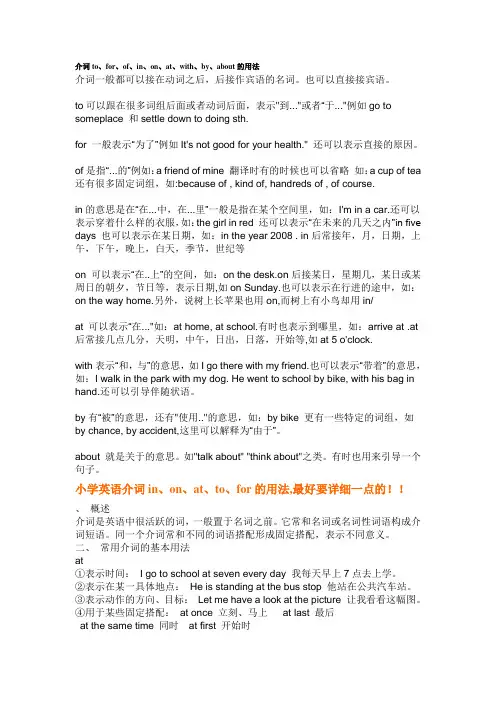
介词to、for、of、in、on、at、with、by、about的用法介词一般都可以接在动词之后,后接作宾语的名词。
也可以直接接宾语。
to可以跟在很多词组后面或者动词后面,表示"到..."或者“于..."例如go to someplace 和settle down to doing sth.for 一般表示“为了”例如It's not good for your health." 还可以表示直接的原因。
of是指“...的”例如:a friend of mine 翻译时有的时候也可以省略如:a cup of tea 还有很多固定词组,如:because of , kind of, handreds of , of course.in的意思是在“在...中,在...里”一般是指在某个空间里,如:I'm in a car.还可以表示穿着什么样的衣服,如:the girl in red 还可以表示“在未来的几天之内”in five days 也可以表示在某日期,如:in the year 2008 . in后常接年,月,日期,上午,下午,晚上,白天,季节,世纪等on 可以表示“在..上”的空间,如:on the desk.on后接某日,星期几,某日或某周日的朝夕,节日等,表示日期,如on Sunday.也可以表示在行进的途中,如:on the way home.另外,说树上长苹果也用on,而树上有小鸟却用in/at 可以表示“在..."如:at home, at school.有时也表示到哪里,如:arrive at .at 后常接几点几分,天明,中午,日出,日落,开始等,如at 5 o'clock.with表示“和,与”的意思,如I go there with my friend.也可以表示“带着”的意思,如:I walk in the park with my dog. He went to school by bike, with his bag in hand.还可以引导伴随状语。
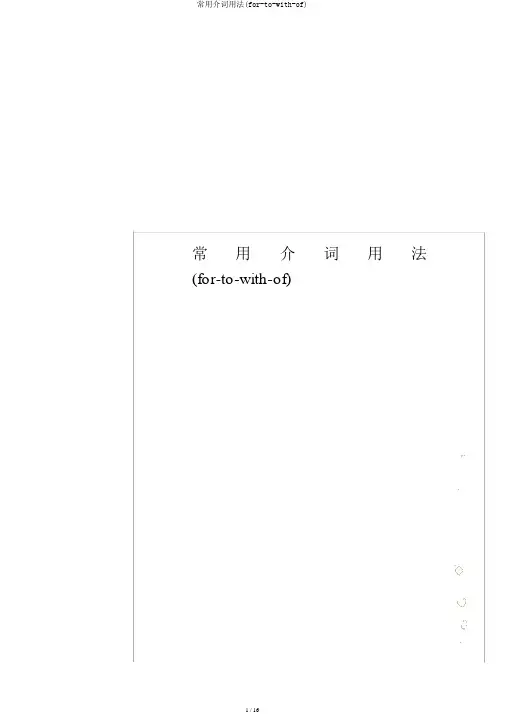
常用介词用法(for-to-with-of)For 的用法1.表示“看作、作”。
如 :I like some bread and milk for breakfast.我喜把面包和牛奶作早饭。
What will we have for supper?我晚饭吃什么?2.表示原因或原因 ,意“因、因为”。
如 :Thank you for helping me with my English.你帮我学英。
3.表示作的象或接受者 ,意“ ⋯⋯”、“ ⋯⋯ (而言 ) ”。
如 :Let me pick it up for you.我你起来。
Watching TV too much is bad for yourhealth.看太多有害于你的健康。
4.表示、距离,意“ 、达”。
如: I usually do the running for an hour in the morning. 我清晨往常跑步一小。
We will stay there for two days.我将在那里停留两天。
5.表示去处、目的 ,意“向、往、取、”等。
如:Let ’ s go for a walk. 我出去漫步吧。
I came here for my schoolbag. 我来儿取包。
I paid twenty yuan for the dictionary.我花了20元本典。
6.表示所属关系或用途 ,意“ 、适于⋯⋯的”。
如:It ’ s time for school. 到上学的了。
Here is a letter for you.儿有你的一封信。
7.表示“支持、成”。
如 :Are you for this plan or against it?你是支持是反个划 ?8.用于一些固定搭配中。
如 :Who are you waiting for?你在等?For example, Mr Green is a kind teacher. 比方,格林先生是一位心地和善的老。
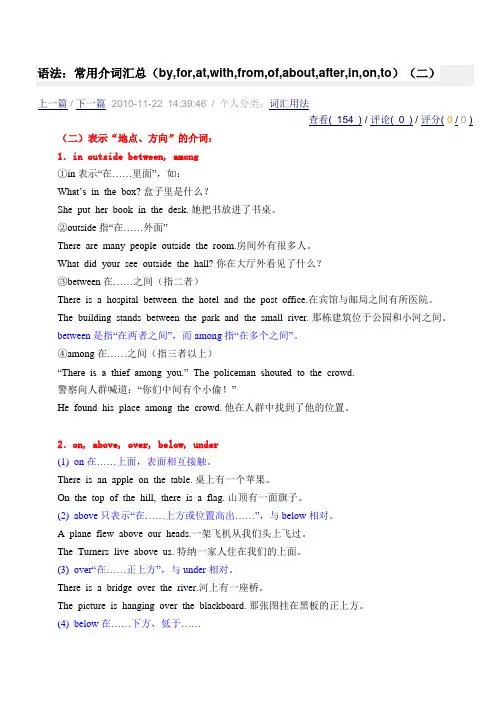
语法:常用介词汇总(by,for,at,with,from,of,about,after,in,on,to)(二)上一篇 / 下一篇 2010-11-22查看( 154 ) / 评论( 0 ) / 评分( 0 / 0 )(二)表示“地点、方向”的介词:1.in outside between, among①in表示“在……里面”,如:What’s in the box?盒子里是什么?She put her book in the desk. 她把书放进了书桌。
②outside指“在……外面”There are many people outside the room.房间外有很多人。
What did your see outside the hall? 你在大厅外看见了什么?③between在……之间(指二者)There is a hospital between the hotel and the post office.在宾馆与邮局之间有所医院。
The building stands between the park and the small river. 那栋建筑位于公园和小河之间。
between是指“在两者之间”,而among指“在多个之间”。
④among在……之间(指三者以上)“There is a thief among you.” The policeman shouted to the crowd.警察向人群喊道:“你们中间有个小偷!”He found his place among the crowd. 他在人群中找到了他的位置。
2.on, above, over, below, under(1) on在……上面,表面相互接触。
There is an apple on the table. 桌上有一个苹果。
On the top of the hill, there is a flag. 山顶有一面旗子。
英语中介词in at from about on by to for of with的用法:⑴时间或地点介词in、on、at的用法区别:表示时间时, in表示在一段时间里(在将来时句子中则表示在一段时间之后), on表示在具体的某一天或者某天的上下午等, at表示在某个时刻或者瞬间;表示地点时, in表示在某个范围之内, on表示在某个平面上或与一个面相接触,at则表示在某个具体的场所或地点。
如:He was born on the morning of May 10th.(他出生于五月十日的早晨)/ I usually get up at 7:00 in the morning.(我通常在早上的七点钟起床) / His glasses are right on his nose.(他的眼镜就架在他的鼻子上)/ He is at the cinema at the moment.(此刻他正在电影院)⑵after与in表示时间的用法区别:“after+(具体时刻/从句)”表示“在…时刻之后”常用于一般时态;“in+(一段时间)”表示“在(多久) 之后”,常用于将来时态。
如:He said that he would be here after 6:00.(他说他六点钟之后会来这儿)/ My father is coming back from England in about a month.(我父亲大约一个月以后从英国回来)⑶since与for表示时间的用法区别:“since+(具体时刻/that-从句)”表示“自从…起一直到现在”,“for +(一段斶间)”表示“总共有…之久”,都常用于完成时态;如:Uncle Li has worked in this factory since 1970.(李叔叔自从1970年起就在这家工厂工作了)/ Uncle Li has worked in this factory for over 30 years. (李叔叔在这家工厂已经工作了30多年)⑷by、in与with表示方式的用法区别:都可以表示“工具、手段”,但是by主要表示“乘坐”某个交通工具或“以……方式”,在被动句中可以表示动作的执行者;in表示“使用”某种语言/文字,with表示“使用”某个具体的工具、手段。
for to 和of的用法区别“for”、“to”和“of”在英语中都是常用的介词,但它们的用法和含义有很大的区别。
1、“for”的用法:1.表示“为了”或“因为”的目的或原因。
例如:“I did it for you.”(我为你做了这件事。
)2.用于表示时间或期限。
例如:“Wait for me for five minutes.”(等我五分钟。
)3.用于表示对象或受益者。
例如:“This book is for children.”(这本书是给孩子们的。
)2、“to”的用法:1.表示方向或目标。
例如:“Go to the store.”(去商店。
)2.表示对某人或某物的关系或连接。
例如:“I talk to my friend every day.”(我每天和我的朋友聊天。
)3.用于某些动词之后,表示动作的接受者或对象。
例如:“Give the book to me.”(把书给我。
)3、“of”的用法:1.表示所属关系或起源。
例如:“The cat is of the black color.”(这只猫是黑色的。
)2.用于描述事物的性质或特征。
例如:“The city of Paris is beautiful.”(巴黎这座城市很美。
)3.用于构成某些短语或固定搭配。
例如:“a bit of”(一点),“a kind of”(一种)等。
总结来说,“for”、“to”和“of”在英语中的用法区别主要体现在它们的含义和所表达的关系上。
在实际应用中,需要根据具体的语境和语法规则来选择合适的介词。
with和for的用法区别一、介词“with”的用法介词“with”在英语中有多种用法,下面将详细介绍这些用法的区别。
1. 表示陪伴关系介词“with”常用于表示人或物之间的陪伴关系。
例如:“I went to the party with my friends.”(我和我的朋友一起去参加派对。
)这句话中,“with”表达了我和我的朋友一同前往派对的情况。
2. 表示具有某种特征或性质介词“with”还可以指示一个物体具有某种特征或性质。
例如:“The room was filled with a sweet fragrance.”(房间里弥漫着甜美的香气。
)这句话中,“with”表示房间充满了甜美的香气。
3. 表示使用工具或手段“with”还可表示使用工具或手段进行某事。
例如:“She wrote a letter with a pen.”(她用钢笔写信。
)这里,“with”表示写信时所使用的工具为钢笔。
4. 表示原因或方式“with”也可表达某个动作发生的原因或方式。
例如:“He looked at her with surprise.”(他惊讶地看着她。
)这句话中,“with”强调了他看着她时的惊讶表情。
5. 表示携带或持有介词“with”还可表示携带或持有某物。
例如:“She came back from the store with bags of groceries.”(她从商店回来,手里拎着袋子装满了杂货。
)这句话中,“with”表达了她在回来时手里携带着装满杂货的袋子。
二、介词“for”的用法介词“for”同样有多种用法,下面将详细解释不同的情况。
1. 表示目的或目标“for”常用于表示某个动作或状态的目的或目标。
例如:“I am studying hard for a better future.”(我正在努力学习,为了一个更好的未来。
)这句话中,“for”表达了学习的目的是追求更好的未来。
with,for,to,of的用法(一)常见介词with, for, to, of的用法介词是英语中非常重要的语法成分之一,它通常用于表达两个语言单位之间的关系。
with, for, to, of是常见的介词,它们有各自的用法。
本文将对这四个介词做详细的介绍。
with的用法with通常表示伴随、连带、具有等含义,常用于以下场合:1.表示伴随的状态或情况:I go to school with my brother.(我和我弟弟一起去学校。
)2.表示使用的工具或手段:I write with a pen.(我使用钢笔写字。
)3.表示某物或某人附带的特殊性质或能力:He is a boy withgreat talent.(他是一个有很强才华的男孩。
)for的用法for通常表示目的、原因、受益者等含义,常用于以下场合:1.表示目的:I’m studying for the exam.(我正在为考试而学习。
)2.表示原因:I’m sorry for what I did.(我为我所做的事感到抱歉。
)3.表示受益人:This present is for you.(这份礼物是给你的。
)to的用法to通常表示方向、目的地、时间等含义,常用于以下场合:1.表示方向:I’m going to the cinema.(我要去电影院。
)2.表示目的地:I’m writing an email to my friend.(我正在给我的朋友写邮件。
)3.表示时间:I’ll meet you at two o’clock.(我将于两点钟见你。
)of的用法of通常表示所属关系、产生关系等含义,常用于以下场合:1.表示所属关系:The roof of the house is made of tiles.(这个房子的屋顶是用瓦片做的。
)2.表示产生关系:I’m a friend of Tom.(我是Tom的朋友。
)以上是with, for, to, of的常见用法。
for,to,with的用法一、介词for的用法介词for在英语中用于表示目的、给予、代表等不同的含义。
下面将详细讨论for的主要用法。
1. 表示目的或目标介词for可以用于表示某事或某人是为了实现特定目的或达成某个结果而存在或进行。
例如:- I'm studying hard for my exams.(我正在为考试努力学习。
)- He went to the gym for fitness.(他去健身房锻炼身体。
)2. 表示给予或适合介词for可以用来表示某人给予他人某物或某种服务,以及某物适合于某人或某情境。
例如:- She bought flowers for her mother.(她给她妈妈买了鲜花。
)- This dress is too big for me.(这件裙子对我来说太大了。
)3. 表示代表在有些情况下,介词for可以用来表示一个人代表另一个人出场、参加活动等。
例如:- The ambassador came to the meeting for the president.(大使代表总统出席会议。
)4. 表示时间段介词for还可以表示时间段,指持续时间长度。
例如:- I have been waiting for you for two hours.(我已经等你等了两个小时了。
)5. 其他用法介词for还有其他一些常见的用法,如表示交换、因为、根据等。
例如:- I'll give you my pen for your book.(我把我的钢笔给你,换你的书。
)- She is famous for her beauty.(她因其美貌而闻名。
)二、介词to的用法介词to在英语中有多种用法,下面将详细讨论to的主要用法。
1. 表示方向或目标介词to可以用于表示某人或某事物朝着特定方向移动或达到某个目标。
例如:- He went to the supermarket to buy some groceries.(他去超市买些杂货。
for与to与of的用法区别
For,of都是介词,所以跟在后面的词动词要加ing,这是他们共有的特性。
for,to,of后都跟人称代词的宾格,这是他们共有的特性。
具体的区别如下:
指代不同:
1、to:向,朝。
2、of:属于(某人)。
3、for:对,供。
扩展资料
用法不同:
1、to:to表示交际的动作一般是单向的。
to表示在某范围之外,两者之间可以互相连接,也可以不连接。
2、of:of是英语中一个常用的介词,助动词,表示……的';由…制成等意思,在英语中有大量词组使用of。
3、for:不表示直接原因,for前多加逗号。
for用法较正式,很少用于口语,一般用于书面语。
侧重点不同:
1、to:有指向性。
2、of:表示状态。
3、for:表示目的性。
For的用法1. 表示“当作、作为”。
如:I like some bread and milk for breakfast. 我喜欢把面包和牛奶作为早餐。
What will we have for supper? 我们晚餐吃什么?2. 表示理由或原因,意为“因为、由于”。
如:Thank you for helping me with my English. 谢谢你帮我学习英语。
3. 表示动作的对象或接受者,意为“给……”、“对…… (而言”。
如:Let me pick it up for you. 让我为你捡起来。
Watching TV too much is bad for your health. 看电视太多有害于你的健康。
4. 表示时间、距离,意为“计、达”。
如:I usually do the running for an hour in the morning. 我早晨通常跑步一小时。
We will stay there for two days. 我们将在那里逗留两天。
5. 表示去向、目的,意为“向、往、取、买”等。
如:Let’s go for a walk. 我们出去散步吧。
I came here for my schoolbag.我来这儿取书包。
I paid twenty yuan for the dictionary. 我花了20元买这本词典。
6. 表示所属关系或用途,意为“为、适于……的”。
如:It’s time for school. 到上学的时间了。
Here is a letter for you. 这儿有你的一封信。
7. 表示“支持、赞成”。
如:Are you for this plan or against it? 你是支持还是反对这个计划?8. 用于一些固定搭配中。
如:Who are you waiting for? 你在等谁?For example, Mr Green is a kind teacher. 比如,格林先生是一位心地善良的老师。
尽管for 的用法较多,但记住常用的几个就可以了。
to的用法:一:表示相对,针对be strange (common, new, familiar, peculiar toThis injection will make you immune to infection.二:表示对比,比较1:以-ior结尾的形容词,后接介词to表示比较,如:superior ,inferior,prior,senior,junior 2: 一些本身就含有比较或比拟意思的形容词,如equal,similar,equivalent,analogousA is similar toB in many ways.3:表示一些先后顺序的形容词,如:second、next,4: to也偶尔出现在个别动词之后,与动词形成固定词组,表示比较,如:preferto,compare to,in contrast tocompare to sth.表示比喻或比拟,而compare with sth.表示比较,如:World is usually compared to a stageCompared with his past,he has changed a lot.Prefer的正确句型是:prefer A to B或prefer doing A to doing B,但当prefer后接动词不定式时,表示比较的介词to就要改成rather than ,如:The undaunted soldier preferred death to surrender.Many people prefer spending money to earning money.They prefer to pursue careers rather than remain home as house wives.5: to与及个别的名词构成比较之意,如:alternativeGoing to an under water concert is a great alternative to going to dinner.三: 表示修饰关系1: 表示回复,反应意思的词,如:answer to question, solution to problem,response to inquiry,reaction to proposal,reply to letter6: 表示与书籍,文本相关的词,如:introduction to passage.7: 表示恭喜或是祝贺,如:The director proposed a toast to the health of the guests.Let’s drink to Dick’s success in business8: 另外还有一些名词符合这种用法,有的具有两者息息相关,缺一不可的含义.如:key to door,invitation to party,四: to还具有依据,伴随,和着节奏的含义,如:sing to piano, chance to the tune, stamp to the rhythm of the song, add salt to taste(一:表示相关联,相连接,如:be related to,be relative to,in relation to ,link to Investigate all the facts related to the problem.People often linked walth to happiness.(二:表示反对和赞同。
1:to引导的表示反对,抗拒,对抗意义的词组。
Be opposed to,be oppsist to,be contrary to,be adverse to,be resistant to ,object to,oppose to,2: to引导的表示同意,赞同意义的词组:consent to,subseribe to,The employer consented to give him a salary raise.表示调整,使符合,使适应的含义,如:adapt to,commodate to, adjust to,conform to,habituate to,fit to,suit to,correspond to,cater toShe tried to habituate herself to the style of plain living.Your action should conform to the interests of the people.3: 表示投降,屈服,服从的含义,如:be subject to,be subordinate to,submit to,subject to,surrender to,give in to,confess to,admit to.The minority is subordinate to the majority少数服从多数五: 表示趋势或倾向,如:tend to,be pron e to,be inclined to,be apt to,be liable to He’s liable to seasickness.You are liable to come to wrong conclusion.七: 表示约束,局限,如:limit to,confine to,resrict toHe’s confined to the house by illness.He confined his remarks to scientific mangement.八: 表示一种习惯或是一种适应性,如:get (be to,used to,Finally,the students got used to my teaching method.九: 表示起因和原由,如:owing to,due to,thanks to,attribute to,come down toThe flight was cancelled due to the thick fog.The famous artist attributed his success to his wife.十: 表示目的或结果,如:aim to,lead to,give rise toI aim to be an excellent college teacher.His conceit lead to his failure.十二: 表示数量上的积累或增加,如:in addition to,add to,amount toIn addition to relief supplies,he also presented with some money.十三: 表示全身心投入的含义,如:be addicted to,contribute to,devote to,commit to He is determined to devote all his life to his.十四: 表示展望或是回顾,如:look forward to反date back toThe church dates back to the 13th century.十五: 表示方位概念.如:close to,next toI don’t like wool next to my skin.十七: 表示有关注,关于: as to,with regard to十八: 表示关注或重视,如:pay attention to,attach to,We should attach primary importance to job training.二十: 表示应该或必须含义的句式, 如:I t’s time to get up.We are supposed to get here at seven.It’s up to this country to ban nuclear weapons.常用词组respond to(反应, appeal to(吸引, catch on to(理解, listen to (收听,used to(过去常常, give birth to,attend to(照料, see to(负责, be entitled to(有权, belong to(属于, come to(苏醒, stand up to(勇敢面对, help oneself to(请自便, refer to,to the point(切题,with的用法1、以, 用, 同...,由于, 和...一致, 赞成, 关于, 就talk with a friend 与朋友谈话learn farming with an old peasant 跟老农学习种田fight [quarrel, argue] with sb. 跟某人打架[争吵, 辩论]2、说明表示动作的词, 表示伴随]随着, 和...同时change with the temperature 随着温度而变化increase with years 逐年增加be up with the dawn 黎明即起W-these words he left the room. 他说完这些话便离开了房间。